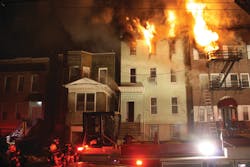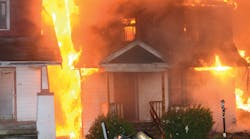Fireground Operations: 15 Priorities in Protecting Exposures: Part 2
Exterior exposures are a major concern for many fire departments. Fire departments that protect congested urban and suburban areas must deal with structures that are built alongside one another. With buildings that are attached to one another or separated by only a few feet, fire extension into adjoining or nearby structures must be considered an early possibility. In these settings, hesitation can let fire not only occupy one, but three buildings in a short amount of time.
In order for incident commanders to direct efficient and effective fireground operations, officers must identify and prioritize protection of exposure buildings from a number of factors.
9
The life hazard – specifically those nearest
Buildings must be prioritized based on “the most severely threatened exposure” versus “the most severely threatened life exposure.” This is not a play on words; there is a difference.
Exterior exposure concerns must immediately focus on determining the “most severely threatened exposure” versus the “most severely threatened life exposure. The most severely exposed or closest building may not necessarily be the one that receives the incident commander’s initial attention. Initial courses of action must be based on any threat to life in nearby or attached properties.
The best way to illustrate this thought is with an example. Let’s say you arrive at a well-involved structure severely exposing a nearby vacant, two-story frame building on the west side and a closely spaced two-story, occupied wood frame on the east side. Now, even though the building to the west is referenced as being severely exposed and closer to the fire building, the occupied building on the east side would warrant the initial exposure protection simply based on the potential life hazard.
As simple as this example is to identify with, everything that we do is based on the life hazard size-up. Additional resources can always be delegated as the incident commander sees fit, but your initial course of action is always based on the life hazard.
10
Exposure proximity
Is the exposure attached or separated, and by how much? Buildings that are attached or separated by narrow alleyways are immediate concerns for responding firefighters. Due to their proximity to one another, resources will have to be assigned to check and protect the buildings from any fire extension.
11
Exterior sheathing/siding
Buildings whose exterior sheathing/siding is combustible can also enhance the fire’s spread from one building to another. Buildings covered in wood or asphalt siding will warrant earlier consideration than those made of brick or stone. Firehouse® Contributing Editor Chief Vincent Dunn of the FDNY has often stated that the combustible exterior siding of a structure can present a seventh side of fire travel. Not only can the involvement of the siding spread up and back into the building itself, but it can quickly spread fire to a nearby exposure building.
Jersey City, NJ, firefighters were confronted with a fire that extended to a building’s exterior asphalt siding and that spread to the asphalt siding of an exposure building (see photo on page XX). A well-supplied hoseline will quickly darken down the exterior fire. But, the problem with this fire, as with all asphalt-siding fires, is that the energy this fire can produce before you get a hoseline stretched and operating.
Asphalt siding is a hydrocarbon-based material; thus the term and comparison used by many as “gasoline siding.” The amount of heat and energy being produced will quickly push fire into buildings through sheathing, windows and roof overhangs. Although an exterior hose stream will extinguish the majority of the outside fire quickly, the energy may have already pushed fire beyond the siding and into the structure.
12
Cocklofts, cornices and shafts
As anyone who has worked at a fire involving a row of attached brick or wood-frame buildings will tell you, fire can and will spread quickly throughout the row. Anticipating the fire’s movement, getting ahead of it and having enough resources to handle the assigned tasks are the necessary ingredients for a successful fire fight. Sounds easy?
Fires in cocklofts continue to challenges fire forces. These spaces can range in height from a few inches to a few feet, and cover the entire city block. Fire departments that encounter these challenges on a daily basis have in their arsenal of tactics procedures that include enlarged primary ventilation holes, trench cutting and cockloft nozzles. Each of these requires a disciplined approach and coordination with interior forces below.
A cornice on the exterior of either a brick or wood frame exterior is a decorative wooden box that if compromised from an exterior fire, can allow fire to burrow into the buildings cockloft.
Light and air shafts between buildings are a problem on an enhanced level. When we have shared light and air shafts throughout a row of wood-frame dwellings, we often find that the shafts are constructed of old, dried-out clapboard, with some even lined or covered with asphalt siding. The shafts often contain garbage or other discarded materials.
Once a fire exits the window of the original fire building and enters a shaft, you have to anticipate it will quickly spread into the exposure building. Fire reported in a shared light or air shaft is one of our cues to transmit a second alarm. Whether that report comes from members operating on the roof or what looks like a blowtorch in the sky where the buildings meet, you are going to need more help.
13
Shared joist pockets
This one could sneak up on you. When we have a fire in a Class 3/ordinary brick-and-wood-joist building attached to a similar structure, members may assume that the brick wall that separates the buildings is a fire stop. The shared wall, often called a “division wall” or “party wall,” is just that; a shared wall. What this means from a construction perspective is that the wood floor and roof-support system will share the bearing wall. Where joists enter the wall for support, they will share or create a “joist pocket” where the wooden floor joist from one building will butt up against or be installed alongside the wooden joists from the neighboring building. This is an area where fire can burrow into and pass through the brick wall into the exposure building.
Whenever you have a fire that involves the structure of the building (support system) and the heat and wood char of the wood extends into or has approached the shared brick wall, it is critical that you check the joist pocket on the other side of the wall. A thorough check is required. Due to the age of the building, these will generally be dried-out timbers that can easily smolder, eventually letting fire move to the other side. Open up, poke, use a thermal imager and get some water up there.
14
Brick nogging
This is a very old building feature that has saved many rows of wood-frame buildings from burning to the ground. Found with the wooden/shared party walls within the row, layers of brick and mortar were constructed in the wall bays to act as a fire stop or means of preventing fire from extending from one wood-frame building to another.
I had a conversation years ago with an old friend and mason who told me that the brick nogging actually increases the R-Value or insulation of a building. But as effective as they are meant to be, they can only stop or halt fire from extending from one building to another if the brick nogging is installed all the way up to the underside of the roof deck.
A recent Jersey City fire involved the top floor of a row of wood frames. The fire extended into the cockloft and into the exposure building above the brick nogging as well as where the brick was missing. Brick nogging is definitely a plus regarding halting fire spread as long as it is in the right place at the right time.
15
Wind speed and direction
There is no doubt that wind speed and direction will influence the spread of a fire. A winds as low as 10 mph in a congested urban setting can become a concern. Winds above 30 mph in the same setting can spread flying brands and embers to numerous structures throughout a neighborhood.
As soon as staffing allows, the incident commander must assign resources to “brand patrol” to extinguish any flying/burning embers from the original fire building before they start additional fires.
Conclusion
Water plus. In addition to the options mentioned above, one of the obvious added requirements to keep fire from spreading from one building to another is water, big water. From bathing the exterior surfaces of exposed buildings with master streams to assigning resources within the building with hoselines to stop the spread within, the challenges are significant. Anticipation and your ability to stay ahead of it continue to be the keys to success.
MICHAEL TERPAK has been in the fire service for 38 years, spending the past 33 years with the Jersey City, NJ, Fire Department, where he is a deputy chief and citywide tour commander. He is the former chief of the city’s Training Division. Terpak is the founder of Promotional Prep, a based consulting firm that prepares firefighters and fire officers for promotional exams. Terpak also holds a bachelor of science degree in fire safety administration from the City University of New Jersey and is the author of the books Fireground Size-Up, Assessment Center Strategy and Tactics and Fire Ground Operational Guides. He can be contacted at 973-726-9538, firegroundsizeup.com or promotionalprep.com. Part one was in the February issue.







